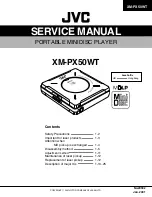
Chapter 6. Sound Settings
55
In some ways the EQ is similar to the
Bass
and
Treble
settings described earlier, but
the EQ allows you to control the sound much more carefully. Note that the parameteric
EQ bands will be applied in addition to any bass or treble tone controls.
Note:
A maximum of 10 EQ bands are possible on most devices, but using more than
b
are required will waste battery and introduce additional rounding noise. For best results,
use the fewest number of bands required.
Rockbox’s parametric EQ is composed of up to ten different bands:
Band 0: Low shelf filter.
The low shelf filter boosts or lowers all frequencies below a
certain frequency limit, much as the “bass” control found on ordinary stereo sys-
tems does. Adjust the “cutoff” frequency parameter to decide where the shelving
starts to take effect. For example, a cutoff frequency of 50 Hz will adjust only very
low frequencies. A cutoff frequency of 200 Hz, on the other hand, will adjust a
much wider range of bass frequencies. The “gain” parameter controls how much
the loudness of the band is adjusted. Positive numbers make the EQ band louder,
while negative numbers make that EQ band quieter. The “Q” parameter should
always be set to 0.7 for the shelving filters. Higher values will add a small boost
around the cutoff frequency that is almost always undesirable.
Bands 1-8: Peaking filters.
Peaking EQ filters boost or lower a frequency range cen-
tered at the centre frequency chosen. Graphic equalizers in home stereos are usually
peaking filters. The peaking filters in Rockbox’s EQ lets you adjust three different
parameters for EQ bands 1 through 8. The “centre” parameter controls the centre
frequency of the frequency range that is affected as described above. The “gain”
parameter controls how much each band is adjusted, and works as for the low shelf
filter. Finally, the “Q” parameter controls how wide or narrow the affected fre-
The Rockbox manual
(version rUnversioned directory-150220)
Sansa e200 and e200R Series
















































